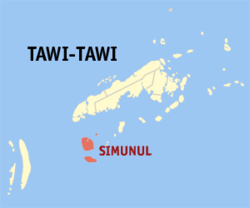Simunul, Tawi-Tawi
| Simunul | |
|---|---|
| Municipality | |
 Map of Tawi-Tawi with Simunur highlighted | |
.svg.png) Simunul Location within the Philippines | |
| Coordinates: 04°54′N 119°50′E / 4.900°N 119.833°ECoordinates: 04°54′N 119°50′E / 4.900°N 119.833°E | |
| Country | Philippines |
| Region | Autonomous Region in Muslim Mindanao (ARMM) |
| Province | Tawi-Tawi |
| District | Lone district of Tawi-Tawi |
| Barangays | 15 |
| Government[1] | |
| • Mayor | Nazif Ahmad Bayo Abduraman |
| Area | |
| • Total | 167.25 km2 (64.58 sq mi) |
| Population (2015 census)[2] | |
| • Total | 31,223 |
| • Density | 190/km2 (480/sq mi) |
| Time zone | PST (UTC+8) |
| ZIP code | 7505 |
| IDD : area code | +63 (0)68 |
| Income class | 4th municipal income class |
| PSGC | 157004000 |
| Electorate | 12,332 voters as of 2016 |
| Website |
www |
Simunul is a fourth class municipality in the province of Tawi-Tawi, Philippines. According to the 2015 census, it has a population of 31,223 people.[2] The municipality consists of 2 islands: the larger eponymous Simunul Island and Manuk Mangkaw (Manuk Manka) Island, 3.5 kilometres (2.2 mi) to the south.
The language spoken is Sama, also known as Sinama. The first Muslims in the Philippines are said to have arrived at Simunur. The first mosque in the Philippines was built here by Sheik Karimul Makhdum. This mosque is called the Sheik Karimal Makdum Mosque. Inside this mosque stands 4 hags where it is repainted every year.
There are six beaches in Simunur. The majority of the people are Muslims.
The militants involved in the 2013 Lahad Datu standoff came from Simunul.[3]
Barangays
Simunur is politically subdivided into 15 barangays.
- Bagid
- Bakong
- Doh-Tong
- Luuk Datan
- Manuk Mangkaw
- Maruwa
- Mongkay
- Pagasinan
- Panglima Mastul
- Sokah-Bulan
- Tampakan (Pob.)
- Timundon
- Tonggusong
- Tubig Indangan
- Ubol
The barangays of Timundon, Manuk Mangkaw, and Luuk Datan are located on Manuk Mangkaw Island; the remaining 12 barangays are located on Simunul Island.
Demographics
| Population census of Simunul | ||
|---|---|---|
| Year | Pop. | ±% p.a. |
| 1903 | 1,440 | — |
| 1918 | 5,818 | +9.76% |
| 1939 | 4,980 | −0.74% |
| 1948 | 5,413 | +0.93% |
| 1960 | 8,724 | +4.06% |
| 1970 | 12,135 | +3.35% |
| 1975 | 20,218 | +10.78% |
| 1980 | 26,816 | +5.81% |
| 1990 | 26,491 | −0.12% |
| 1995 | 29,254 | +1.88% |
| 2000 | 31,962 | +1.92% |
| 2007 | 38,239 | +2.50% |
| 2010 | 34,538 | −3.64% |
| 2015 | 31,223 | −1.90% |
| Source: Philippine Statistics Authority[2][4][5][6] | ||
References
- ↑ "Official City/Municipal 2013 Election Results". Intramuros, Manila, Philippines: Commission on Elections (COMELEC). 1 July 2013. Retrieved 5 September 2013.
- 1 2 3 Census of Population (2015). "ARMM - Autonomous Region in Muslim Mindanao". Total Population by Province, City, Municipality and Barangay. PSA. Retrieved 20 June 2016.
- ↑ Arlyn dela Cruz (February 16, 2013). "Heirs of Sultan of Sulu pursue Sabah claim on their own". Inquirer.net. Philippine Daily Inquirer. Retrieved 2 September 2014.
- ↑ Census of Population and Housing (2010). "ARMM - Autonomous Region in Muslim Mindanao". Total Population by Province, City, Municipality and Barangay. NSO. Retrieved 29 June 2016.
- ↑ Census of Population (1995, 2000 and 2007). "ARMM - Autonomous Region in Muslim Mindanao". Total Population by Province, City and Municipality. NSO. Archived from the original on 11 November 2011.
- ↑ "Province of Tawi‑tawi". Municipality Population Data. Local Water Utilities Administration Research Division. Retrieved 17 December 2016.
